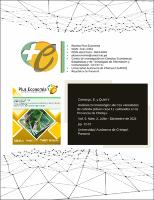Análisis bromatológico de tres variedades de cebolla (allium cepa l.) cultivadas en la Provincia de Chiriquí

Fecha
2021-07Autor
Camargo, Esmith B.
Quiel, Yisselle
Metadatos
Mostrar el registro completo del ítemResumen
The onion (Allium cepa L.),is an herbaceous plant with a reduced stem with enormous leaves, a fleshy and swollen base that constitutes the bulb, rich in nutrients. The first references date back to about 3 200 BC, when they were cultivated by the Egyptians, Greeks and Romans. In the MiddleAges it was cultivated in the Mediterranean, where the large bulb varieties were selected. It occupies the second place according to the volume produced, (after tomato), as the main vegetables worldwide. Latin America represents 9% of world production, the largest producers being Mexico, Brazil and Argentina. The main objective of the study is to determine the chemical composition of three varieties grown in the province of Chiriquí: the varieties Gladalan Brown, Regia and Seilux.Percentage of moisture, ash, protein, crude fiber, fat, carbohydrate and macros and micro elements are determined. In our country, onion cultivation has had great relevance since 1950, but we are not yet self-sufficient. La cebolla (Allium cepa L.), es una planta herbácea de tallo reducido con enormes hojas, base carnosa e hinchada que constituye el bulbo, rico en nutrientes. Las primeras referencias se remontan hacia 3 200 a.C., cuando fueron cultivadas por los egipcios, griegos y romanos. En la Edad Media se cultivó en el mediterráneo, donde se seleccionaron las variedades de bulbo grande. Ocupa el segundo lugar de acuerdo al volumen producido, (después del tomate), como principales hortalizas a nivel mundial. La América Latina representa el 9% de la producción mundial, siendo los mayores productores México, Brasil y Argentina. El objetivo principal del estudio es determinar la composición química de tres variedades cultivadas en la provincia de Chiriquí: las variedades Gladalan Brown, Regia y Seilux. Se determina porcentaje de humedad, ceniza, proteína, fibra cruda, grasa, carbohidratos y los macros y micro elementos. En nuestro país, el cultivo de cebolla ha tenido gran relevancia desde el año 1950, pero aún no somos autosuficientes.
URI
http://jadimike.unachi.ac.pa/handle/123456789/722https://revistas.unachi.ac.pa/index.php/pluseconomia/article/view/498
